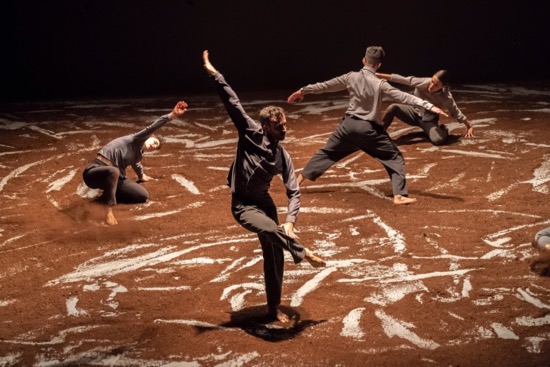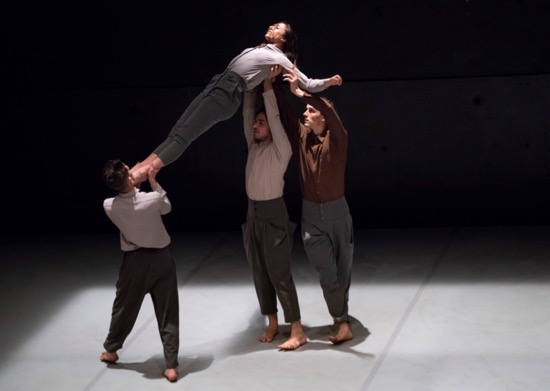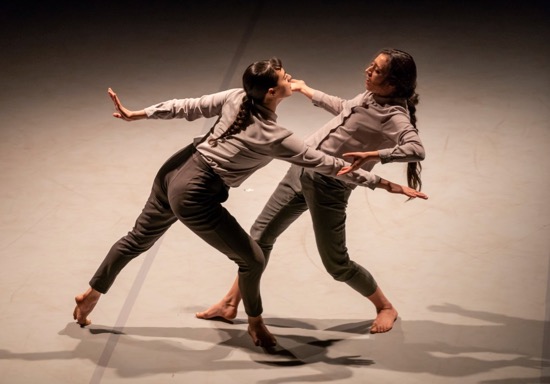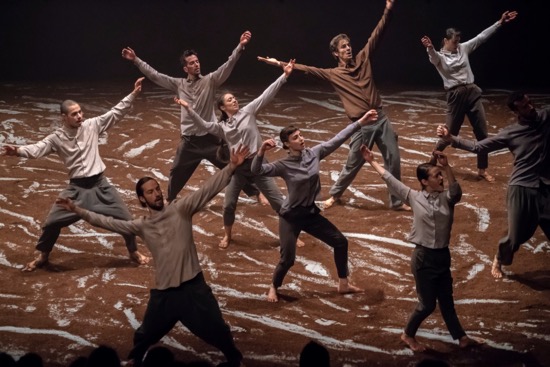
Watching nine members of Israel’s Jerusalem-based Vertigo Dance Company perform One. One & One at the Baryshnikov Arts Center, you don’t think of green pastures and rippling brooks, you imagine rocky or sandy terrain being dug into and turned over and wrestled into fertility. Soil itself figures in this dance by Noa Wertheim, with Rina Wertheim-Koren as a co-creator. To sounds of rumbling, of thunder, of shovels at work, one man (Daniel Costa) backs across the front of the stage, carefully spilling a line of red-brown earth from a large bucket. Eventually, two additional lines of dirt will be laid down; later still, people rush around the stage, hurling more dirt from pails as they go.
When the members of this community dance, their feet trace circles and arcs and tangles in the increasingly mottled surface of their terrain. Since the choreography pushes them from jumping and striding into falling to the floor and rising again, their shirts and pants (by Sasson Kedem), their hair, and their faces become pocked with earth. This deters them not a whit. The soil even becomes part of a conversation: at some point, as Korina Fraiman and Costa approach each other slowly, one, then the other, throws a small handful of dirt at—yet somehow not at—his/her opposite; they end in a hug.

A remarkable solo by Shani Licht at the beginning of One. One & One alerts us to how these people move and think. She dances slowly and forcefully, as if she’s shaping her world, or perhaps being shaped by it. She arches back so far that you imagine her being pressed down. Her feet are often planted wide apart, her knees bent, yet her legs may twist around each other or kick out, her hips swing (but not enticingly). This is dance as work, but also as dreaming (some of her movements will reappear later, performed by others in other contexts). When three men lift her, set her down, lift her, and set her down elsewhere, they don’t look like furniture movers, but as if they’re trying to understand her. As she advances carefully, they follow her closely, ducking under and passing over one another as together they braid her long hair.
Roy Vatury’s set design abets the image of community. A long bench stretches along either side of the stage, and people often sit on these to watch what their colleagues are doing. The lighting by Dani Fishof – Magenta occasionally alters their world (say by projecting a checkerboard of squares on the floor), but the score composed by Avi Belleli enhances Wertheim’s choreography in quite particular ways—creating noises of chaos, gentling down, turning sweet, calling out, muttering, whistling, falling silent. At times, it provides a lively beat to manage the dancers into unison.
We come to know the choreography’s codes, if not always certain what they conceal. Whether moving in unison or individually, we see the dancers shake their hands vigorously, caress their heads, frantically gather in invisible substances, throw their arms high, slap and brush their thighs as if to rid themselves of dirt. But we’re not invited to consider anything as pantomimic. All these gestures, rhythmic and exact, are combined with forceful footwork, canted leaps, spins, big spraddle-legged jumps, and falls to the floor. At moments, you can see a hint of a folk dance, re-imagined.

There are mysteries. Licht and Hagar Schachal, standing close together and facing each other, might be fighting, but they’re not. They circle one another, lock together, almost butt chests, draw back, and lean in. Yet their duet looks non-combative, almost experimental, almost pensive. In a later sequence, Schachal has been dancing, bending into that back arch, watched by five others (Jeremy Alberge, Yotam Baruch, Sándor Petrovics, Etai Peri, and, as I remember, Liel Fibak). When they begin rushing around, you sense that they are following her, wanting to help her; she doesn’t seem to feel chased. However, when they catch her and lift her lying flat and prone, you become uncertain. They run with her this way, put her down, pick her up again, travel elsewhere. Finally, all five pin her down by lying over her; she tries unsuccessfully to get away, but they roll her to a corner and, finally, out of sight.

When Fibak dances close to the audience in the Baryshnikov’s black-box Jerome Robbins Theater, you notice that her gray shirt gets pulled up by her motions, and that she’s unconcerned about that. Some of the solos that erupt like hers make the dancers appear to be buffeted by strong winds or toppled by unseen forces. Yet they weather all these storms, the women as strong as the men. Continuing a sequence in which the women charge erratically across the stage, each launching herself onto one of the waiting men, Korina Fraiman not only jumps onto Petrovics many times, she ends up with him draped over her shoulder and carries him offstage. She is the smallest of the women; he is the tallest of the men.
The movement may be fierce but the dancers’ concern for one another is constant. Those who come and go on the benches seem always ready to join or intervene. At the end of the piece, when Licht and (as I recall) Petrovics are clinging together and leaning apart, and a cello is singing sweetly, the others stand in place, their arms spreading like wings—would-be angels flying nowhere. Finally, as the music dwindles into sustained tones and a high held note, one man just sits quietly, watching an empty stage as the lights dim.
This powerful piece of Wertheim’s conveys a desire for unity in a dangerously fragmenting world, whether that “world” is an exterior landscape or an interior one. Or both.

I liked it, too. Afterward, I asked the two guys charged with cleaning up the stage floor whether the soil has to serve for all the performances (it does) and how they clean the surface back to white marley or whatever (first, they wrap huge mops in cloth and push the soil into one clump, which they shovel back into the buckets; then, they get on their hands and knees and clean the floor with what are essentially tooth brushes–takes about an hour and a half). Thinking the earth must be special, perhaps transported on tour from Israel, I asked where it comes from. Their answer: Home Depot. My answer: the imagination of Pina Bausch.
Fascinating review, account of performance; I’ve seen this company a couple of times here in Portland and always found the work engaging both intellectually and emotionally. And Ms. Aloff’s comment above made me smile: Pina Bausch indeed.